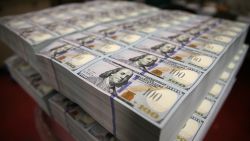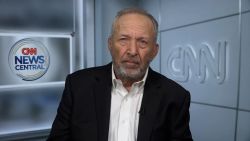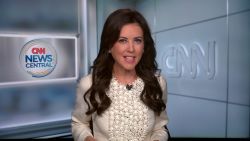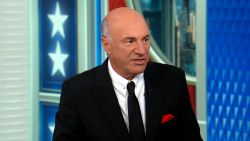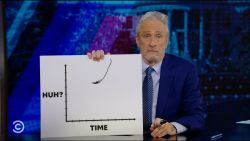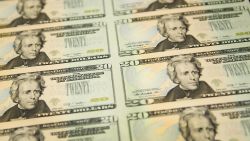A version of this story first appeared in CNN Business’ Before the Bell newsletter. Not a subscriber? You can sign up right here. You can listen to an audio version of the newsletter by clicking the same link.
Fed decision day is here — and so is some potential bad news for the market.
That’s because investors have gotten their hopes up again that the central bank will indicate it plans to ease up on hiking interest rates in its battle against rising prices. The problem is the enthusiasm could turn faster than you can say “inflation.”
What’s happening: The Dow ended October up 14%, its best monthly gain since January 1976. The Nasdaq rose about 4% last month while the S&P 500 was up 8%. Part of that was thanks to solid corporate earnings: Companies from GM to Coca-Cola reported strong profits and sales for the third quarter.
Additionally, comments from Fed officials and press reports led the markets to buy into the idea that even though the central bank will likely raise interest rates by three-quarters of a percentage point at its Wednesday meeting, December’s increase could be smaller.
According to the CME Fedwatch tool, as of Tuesday evening, markets were betting on an 84% chance that the Federal Reserve will hike interest rates by three-quarters of a percentage point on Wednesday.
Expectations for the December meeting were more divided, though. The market put chances of a three-quarter point hike at 50%. The probability of a smaller, half-point hike sat at 43%, but that was up from 29% just two weeks ago, signaling a growing optimism among investors.
We’ve been here before: This isn’t the first time investors rushed into markets on the belief that there would be a Fed pivot. That didn’t go so well. The last time the market ran with a pivot narrative over the summer, Fed Chairman Jerome Powell responded with a very hawkish speech at Jackson Hole that sent markets plummeting. The Fed ended up delivering more hikes in the months that followed.
Investors are seemingly addicted to the highs and lows of any perceived shifts in the Fed’s thinking, leaving markets excessively volatile.
What investors are watching: A potential easing of interest rate hikes will likely be discussed at this month’s meeting, but the eventual peak in the fed funds rate will be dependent on economic data that has yet to be released.
As the pivot narrative once again grows on Wall Street, it will take a carefully orchestrated press conference and statement from the Fed to correct expectations while keeping markets from crashing again.
This week’s statement will not include updated economic projections, so investors will pay close attention to Powell’s post-meeting press briefing for clues that could shape financial markets in the weeks to come.
“The risk for the Fed headed into the upcoming meeting is how to communicate its true intentions, knowing that markets may latch onto any sign of stepping back from front-loading as a sign of an intended pause in the ongoing rate hikes,” wrote Steven Ricchiuto, US chief economist of Mizuho Securities USA in a note.
Now that markets have rallied “we believe the Chairman will emphasize the risks of pausing too soon over the risks of overtightening as the main driver of policy,” said Ricchiuto. “If we are correct, there will need to be a sharp correction in the markets.”
BP announces $2.5 billion share buyback as profit soars
BP’s profit more than doubled in the third quarter of the year, extending a bumper run of earnings for the world’s biggest oil and gas companies, reports my colleague Hanna Ziady.
The UK-based energy company posted a profit of $8.15 billion in the July to September period, compared with $3.3 billion a year ago. Earnings were boosted by “exceptional” results in gas trading, BP said in a statement on Tuesday.
The result means that Big Oil — BP (BP), Shell, ExxonMobil and Chevron (CVX) — has made more than $58 billion in profits for the third quarter alone. The record earnings come as growing numbers of households in Europe and North America are squeezed by decades-high inflation driven by spiraling energy and food bills.
Shareholders, meanwhile, are benefiting handsomely. BP said it would use surplus cash to buy back shares worth $2.5 billion, bringing total share buybacks this year to $8.5 billion. Shell has spent $18.5 billion on share buybacks this year and made juicy dividend payments on top of that.
The unprecedented set of earnings is fueling renewed calls in Britain and the United States for windfall taxes on energy companies to help households that are struggling to pay rising bills.
The IPO market has unraveled this year
There has been little demand for private companies to make their debuts with initial public offerings this year, reports my colleague Paul R. La Monica.
Only two companies went public last month. According to data from IPO research firm Renaissance Capital, that was the slowest October for the US IPO market since 2011. What’s more, only 66 companies have gone public so far this year, down more than 80% from a year ago.
Several high-profile unicorns — the nickname bestowed upon startups that are valued at $1 billion or more based on their most recent round of funding — have reportedly pushed off plans to go public this year. Many hope to do so instead in 2023 if the broader market improves.
That list reportedly includes grocery shopping service Instacart, social media site Reddit and fintech giant Stripe.
Still, there is some hope that the market for traditional IPOs might be slowly turning around.
One of the two companies that did go public in October was Mobileye, a self-driving car company that had been owned by chip giant Intel (INTC). Demand was strong for Mobileye’s stock. Shares were priced above their offering range and surged nearly 40% on their first day of trading.


